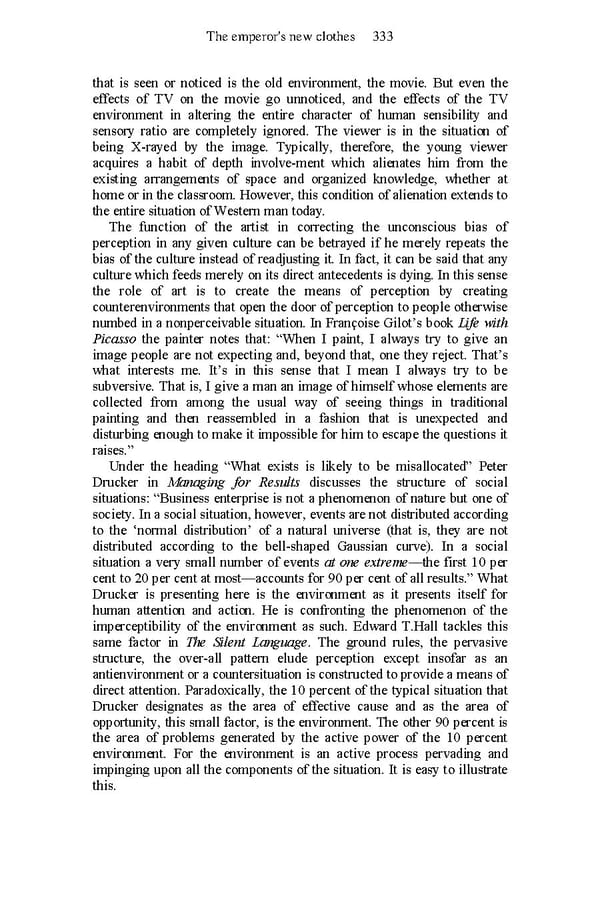The emperor's new clothes 333 that is seen or noticed is the old environment, the movie. But even the effects of TV on the movie go unnoticed, and the effects of the TV environment in altering the entire character of human sensibility and sensory ratio are completely ignored. The viewer is in the situation of being X-rayed by the image. Typically, therefore, the young viewer acquires a habit of depth involve-ment which alienates him from the existing arrangements of space and organized knowledge, whether at home or in the classroom. However, this condition of alienation extends to the entire situation of Western man today. The function of the artist in correcting the unconscious bias of perception in any given culture can be betrayed if he merely repeats the bias of the culture instead of readjusting it. In fact, it can be said that any culture which feeds merely on its direct antecedents is dying. In this sense the role of art is to create the means of perception by creating counterenvironments that open the door of perception to people otherwise numbed in a nonperceivable situation. In Françoise Gilot’s book Life with Picasso the painter notes that: “When I paint, I always try to give an image people are not expecting and, beyond that, one they reject. That’s what interests me. It’s in this sense that I mean I always try to be subversive. That is, I give a man an image of himself whose elements are collected from among the usual way of seeing things in traditional painting and then reassembled in a fashion that is unexpected and disturbing enough to make it impossible for him to escape the questions it raises.” Under the heading “What exists is likely to be misallocated” Peter Drucker in Managing for Results discusses the structure of social situations: “Business enterprise is not a phenomenon of nature but one of society. In a social situation, however, events are not distributed according to the ‘normal distribution’ of a natural universe (that is, they are not distributed according to the bell-shaped Gaussian curve). In a social situation a very small number of events at one extreme—the first 10 per cent to 20 per cent at most—accounts for 90 per cent of all results.” What Drucker is presenting here is the environment as it presents itself for human attention and action. He is confronting the phenomenon of the imperceptibility of the environment as such. Edward T.Hall tackles this same factor in The Silent Language. The ground rules, the pervasive structure, the over-all pattern elude perception except insofar as an antienvironment or a countersituation is constructed to provide a means of direct attention. Paradoxically, the 10 percent of the typical situation that Drucker designates as the area of effective cause and as the area of opportunity, this small factor, is the environment. The other 90 percent is the area of problems generated by the active power of the 10 percent environment. For the environment is an active process pervading and impinging upon all the components of the situation. It is easy to illustrate this.
 Essential McLuhan Page 339 Page 341
Essential McLuhan Page 339 Page 341